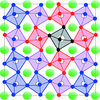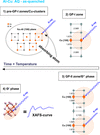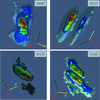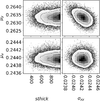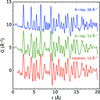issue contents
October 2018 issue

Cover illustration: Probing the intrinsic and extrinsic origins of piezoelectricity in lead zirconate titanate single crystals. Three-dimensional reconstruction of the intensity distributions in the reciprocal space around four {hkl} sets of Bragg reflections. Courtesy of Zhang et al. [J. Appl. Cryst. (2018), 51, 1396-1403].
research papers
Open  access
access
 access
accessSerial crystallography using electron diffraction has been developed as a fully automated method for collecting electron diffraction data from a large number of crystals. It is demonstrated how the data can be used for structure determination and phase analysis.
A far-field double-crystal diffractometry technique using synchrotron X-rays was employed to record lattice parameters of an Ni-base single-crystal superalloy with a high frequency (every 7 s) during an in situ creep test. Diffraction scans reveal the presence of subgrains. This article describes this technique and the associated data processing to obtain results that open new scientific opportunities to follow crystalline materials in real time.
A new hypothesis for the ferroelectric relaxor behavior variation in BaTiO3 synthetic perovskite doped with Ce4+ is presented. The pair distribution function is used to explore the local structure and to propose a new local structural model consisting of oxygen octahedron tilting coupled with titanium displacements.
A data-reduction procedure for the removal of the effect of geometric factors from the angle-dependent specular X-ray reflectivity profile of small samples is described.
Operando powder X-ray diffraction measurements on layered P2-NaxNi0.3Mn0.7O2 provide detailed insight into non-equilibrium structural changes in the cathode material during charge and discharge.
This paper describes use of a combination of experimental and calculated small-angle neutron scattering/neutron diffraction profiles for the analysis of power law exponent evolution with different typical changes in structure and microstructure properties of swelling clay minerals.
Open  access
access
 access
accessCommercial glassy carbon plates (NIST SRM 3600) being used as absolute intensity calibration standards in small-angle X-ray scattering applications are further characterized in terms of hydrogen content, vibrational density of states and specific heat capacity.
The cosα method was applied to measure triaxial residual stresses of uni-directionally machined surfaces of a carbon steel made by grinding, milling and planing. A recommended procedure for experimental measurements of in-plane normal and shear stresses and out-of-plane shear stresses is proposed, together with a new method for determination of the out-of-plane normal stress.
Time-resolved X-ray absorption spectroscopy provides a powerful method to investigate the very early stages and precipitation sequence of the model system Al–Cu. Small changes in the local atomic structure of the probed element can be observed and verified by X-ray absorption fine structure simulations using ab initio calculated atomic coordinates as simulation input.
A fast X-ray-diffraction-based procedure for measuring crystallite size distributions is presented. Unprecedented precision and accuracy is achieved with a data acquisition fast enough to permit in situ studies under non-ambient conditions.
Open  access
access
 access
accessX-ray topography analysis reveals the presence of stacking faults in β-Ga2O3 wafers grown by the edge-defined film-fed growth method. These stacking faults are found to be associated with a Shockley-type partial dislocation loop on the basis of the contrast extinction rules determined by varying the value of the diffraction vector.
Open  access
access
 access
accessThis article describes a modeling framework to relate the molecular orientation of nanostructures to polarized resonant soft X-ray scattering measurements using the Born approximation and a full tensor treatment.
The complete structure of single GaAs/(In,Ga)As/GaAs core–shell–shell nanowire heterostructures has been determined in the as-grown geometry. This has been done by probing in-plane Bragg reflections by means of X-ray nanodiffraction using synchrotron radiation and by nanowire modelling using finite-element methods.
A new X-ray-diffraction-based experiment and data analysis technique for probing the origins of the piezoelectric effect in multi-domain ferroelectric/ferroelastic single crystals is introduced. The technique has been demonstrated for PbZr1−xTixO3 (x = 0.45).
A function can be considered a physical scattering density fluctuation if the modulus of its Fourier transform, evaluated over a finite volume V and divided by V1/2, tends to a bounded non-vanishing function as V → ∞ and if the squared limit obeys the Porod invariant relation.
Open  access
access
 access
accessAn easy to perform rotation calibration procedure has been developed for miniKappa and/or other multi-axis goniometers used in macromolecular crystallography to enhance the precision of experiments involving crystal reorientations.
A method of high-resolution reciprocal space mapping and strain scanning using the back focal plane in dark-field X-ray microscopy is introduced.
The structure of a hypothetical layer ensemble with stacking disorder is globally refined from simulated pair distribution function (PDF) data using hierarchically constrained models, highlighting the availability of interlayer atomic correlations within the PDF – information that is often non-trivial to obtain from powder diffraction data.
Local symmetry reduction in several ternary metal hexaborides is shown through X-ray total scattering, Raman spectroscopy and high-resolution transmission electron microscopy.
Open  access
access
 access
accessThe means by which multiple scattering contributions in experimental small-angle scattering data can be estimated, and how they can be included in the data analysis, are reviewed and discussed. The multiple scattering effects for a range of relevant model scattering functions are calculated using semi-analytically derived solutions to Hankel transforms as well as Monte Carlo simulations.
The structure of crystalline particles of submicrometre size formed in an amorphous thin-film matrix by electron irradiation has been re-analysed. It is found that the unusual diffraction patterns observed in earlier reports, which suggested a hexagonal structure, can be explained by the standard diamond cubic structure but with a complex microstructure: fine twins and dense stacking faults on {111} planes. High-resolution lattice images support this interpretation.
teaching and education
Free 

The use of crystal growth as the basis for laboratory experimentation will train students majoring in sciences, but more importantly, it stimulates their interest in carrying out and maintaining a research project of their own.
Free 

The classification of space groups into types, classes, systems and families is explained.
computer programs
PDFgetN3, a software program for obtaining pair distribution functions from constant-wavelength neutron powder diffraction data, is presented.
Open  access
access
 access
accessA new software program, xINTERPDF, that analyzes the intermolecular correlations in organic compounds via measured X-ray total scattering data is described.
A web-based flexible scientific data reduction system is presented, which accesses published data stores and transforms raw measurements into interpretable data through data flow diagrams that are converted to advanced calculations on a Python 3 back end; the results are returned in real time through the web interface. The application was developed for handling neutron and X-ray reflectometry results at a user facility.
crystallographers
Free 

book reviews
Free 



 journal menu
journal menu












